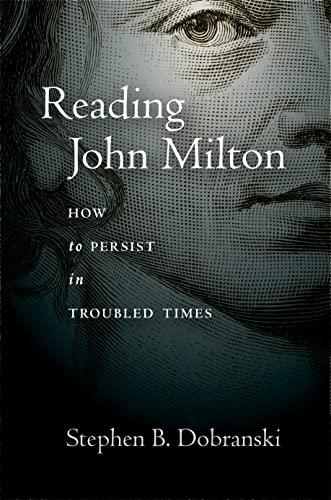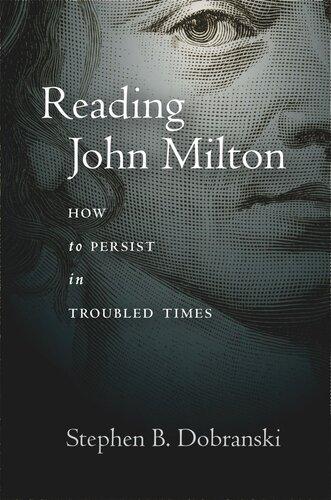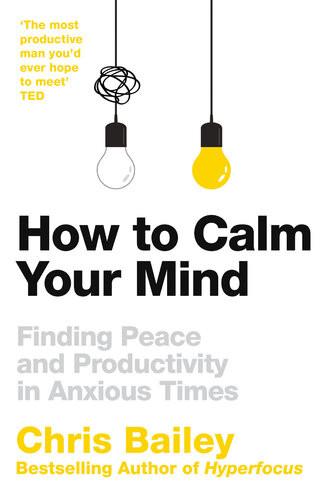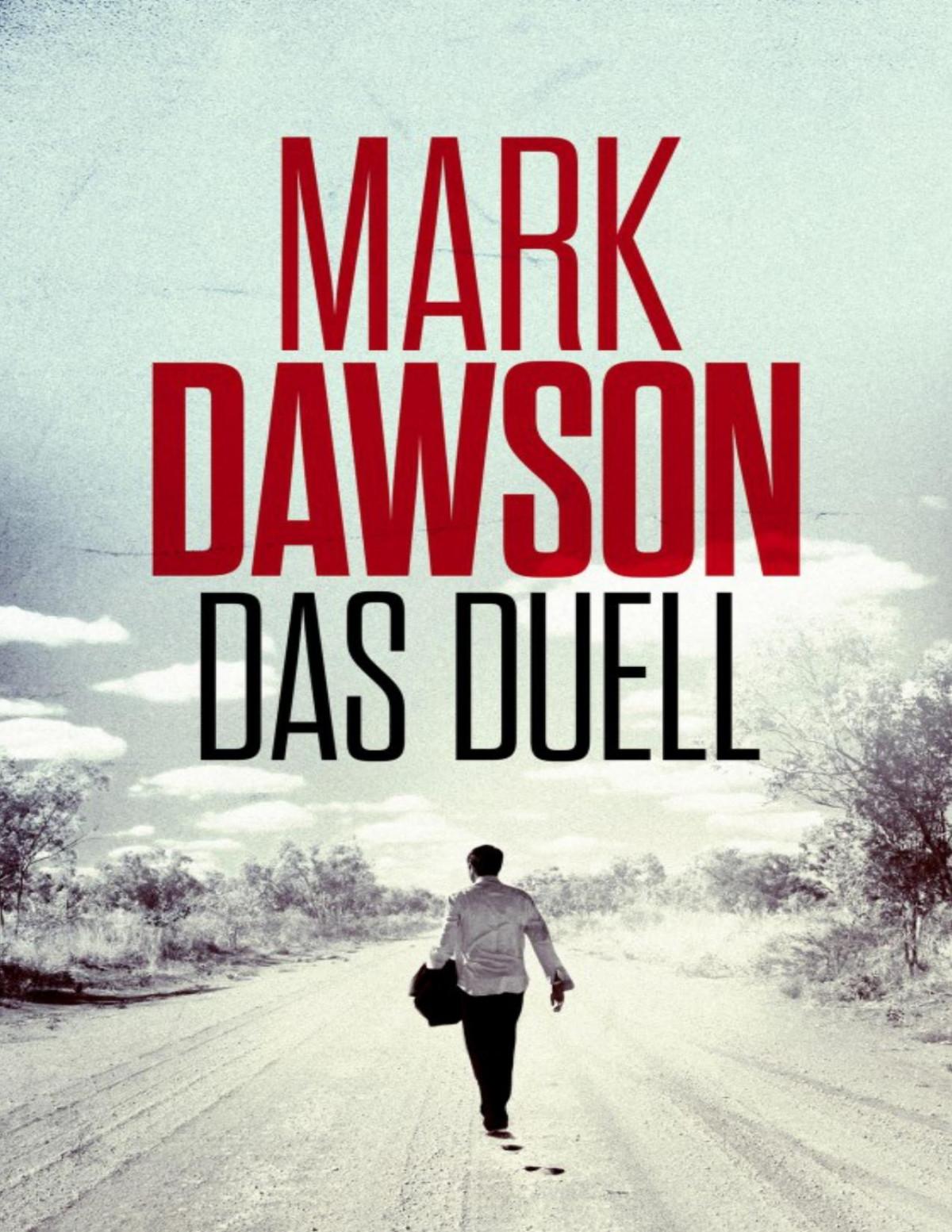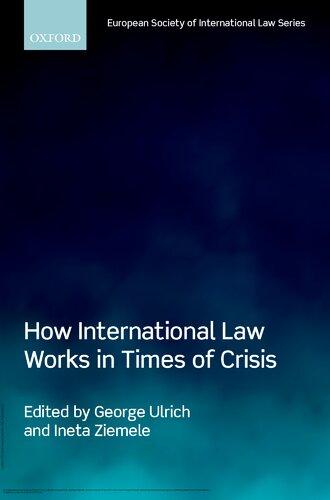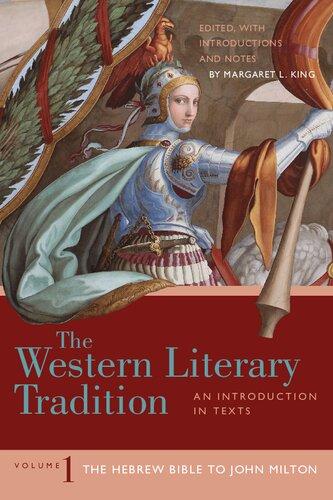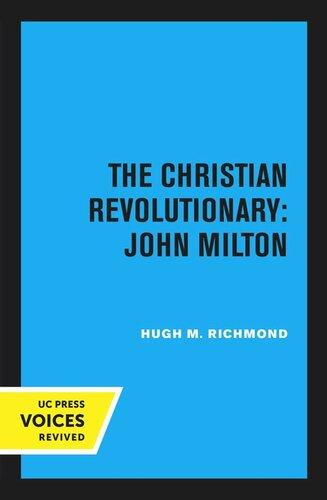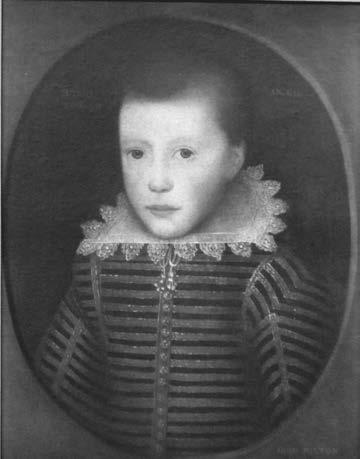Reading John Milton
How to Persist in t r oubled t i mes
Stephen B. Dobranski
Stanford Univer S i ty Pre S S Stanford, California
STANFORD UNIVERSITY PRESS
Stanford, California
© 2022 by Stephen B. Dobranski. All rights reserved.
No part of this book may be reproduced or transmitted in any form or by any means, electronic or mechanical, including photocopying and recording, or in any information storage or retrieval system without the prior written permission of Stanford University Press.
Printed in the United States of America on acid-f ree, archival-quality paper
Library of Congress Cataloging-in-Publication Data
Names: Dobranski, Stephen B., author.
Title: Reading John Milton : how to persist in troubled times / Stephen B. Dobranski.
Description: Stanford, California : Stanford University Press, 2022. | Includes bibliographical references and index.
Identifiers: LCCN 2022004022 (print) | LCCN 2022004023 (ebook) | ISBN 9781503632707 (cloth) | ISBN 9781503633308 (ebook)
Subjects: LCSH: Milton, John, 1608-1674. | Poets, English—Early modern, 1500 -1700 —Biography.
Classification: LCC PR3581 .D63 2022 (print) | LCC PR3581 (ebook) | DDC 821/. 4 [B]—dc23/eng/20220425
LC record available at https://lccn.loc.gov/2022004022
LC ebook record available at https://lccn.loc.gov/2022004023
Cover design: Rob Ehle
Cover art: Engraving of John Milton, ca. 1887. iStock
Typeset by Elliott Beard in ITC Galliard 10/15
To Shannon and Audrey, yet once more and always
This page intentionally left blank
He above the rest
In shape and gesture proudly eminent
Stood like a tow’r; his form had yet not lost
All her original brightness, nor appeared Less than Archangel ruined, and th’ excess Of glory obscured: as when the sun new ris’n Looks through the horizontal misty air
Shorn of his beams, or from behind the moon
In dim eclipse disastrous twilight sheds On half the nations, and with fear of change Perplexes monarchs. Darkened so, yet shone Above them all th’ Archangel: but his face Deep scars of thunder had intrenched, and care Sat on his faded cheek, but under brows Of dauntless courage . . .
Paradise Lost, Book 1, lines 589 – 6 03
LIST OF ILLUSTRATIONS
FIGURE 1. Portrait of John Milton (at age ten) 2
FIGURE 2. Robert Devereux 10
FIGURE 3. Ludlow Castle, the Round Chapel 21
FIGURE 4. Engraved title page of Comus: A Mask 23 by John Milton (1791)
FIGURE 5. William Blake, Illustration 1 to Milton’s A Masque : Comus and His Revellers (c 1801). Pen and watercolor. 26
FIGURE 6. Portrait of Milton at age twenty-one 30 af ter George Vertue, 1725
FIGURE 7. Engraving of Thomas Hobson by John Payne (1631) 47
FIGURE 8. Koblenzer Portrait of Sara Milton, the Author’s Mother 50
FIGURE 9. Frontispiece portrait of Milton (at age twenty-one), 52 engraved by W. C. Edwards after Cornelius Jansen from The Poetical Works of John Milton, 2 vols. (New York: D. Appleton, 1856).
FIGURE 10. James Barry, Satan, Sin and Death 58
FIGURE 11. Lancelot Andrewes. Oil on canvas. 66
FIGURE 12. Charles I, King of England, from Three Angles by 70 Anthony Van Dyck, 1636. Oil on canvas. Royal Collection, Windsor Castle, Berkshire.
FIGURE 13. Engraving of Charles II touching the scrofulous 75 by R . White (1684)
FIGURE 14. Carisbrooke Castle 77
FIGURE 15. Frontispiece portrait of Charles I from 82 Eikon Basilike (London, 1649)
FIGURE 16. Oliver Cromwell by H. Robinson, based 91 on t he painting by Robert Walker. Oil on canvas.
FIGURE 17. Milton and His Daughters by George Romney 108 from The Poetical Works of John Milton, 3 vols., ed. William Hayley (London, 1794 –1797)
FIGURE 18. William Prynne in the pillory 118
FIGURE 19. Title page of Areopagitica by John Milton 120 (London, 1644)
FIGURE 20. Dedication to the Tribune Tower 122
FIGURE 21. First page of the surviving manuscript 133 of Milton’s Christian Doctrine
FIGURE 22. Michael Burgesse, illustration opposite page 1, 141 i n Milton, Paradise Lost (London, 1688)
FIGURE 23. John Martin, illustration for book I, line 314, in 143 T he “Paradise Lost” of Milton with Illustrations, Designed and Engraved by John Martin (London: Septimus Prowett, 1825–1827)
FIGURE 24. Frontispiece illustration of the War in Heaven 152 by Gustave Doré from Milton’s “Paradise Lost” (London: Cassell, 1870)
FIGURE 25. Illustration of Satan’s return to hell by Gustave Doré 156 from Milton’s “Paradise Lost” (London: Cassell, 1870)
FIGURE 26. As They Thirsted by Gustave Doré from 170 Milton’s “Paradise Lost,” edited with notes and a life of Milton by Robert Vaughan (London: Cassell, Petter, and Galpin, 1866)
FIGURE 27. William Blake, Illustration to Milton’s 179 Paradise Lost: The Temptation and Fall of Eve. Watercolor.
FIGURE 28. Cromwell in the Battle of Naseby in 1645 (1851) 183 by Charles Landseer. Oil on canvas.
FIGURE 29. Adam Resolved to Share His Fate with Eve by 186 Henry Fuseli from The Poetical Works of John Milton, 3 vols., ed. William Hayley (London, 1794 –1797)
FIGURE 30. William Blake, Illustration 5 to Milton’s Paradise Lost: 188 Satan Watching the Endearments of Adam and Eve (1807). Pen and watercolor.
FIGURE 31. Charles II Landing in Dover amid 192 Popular Rejoicing. Etching by W. Sharp after B. West.
FIGURE 32. Illustration by J.M.W. Turner, The Temptation 203 on the Mountain, from The Poetical Works of John Milton, 3 vols. (London: John Macrone, 1835)
FIGURE 33. Illustration by J.M.W. Turner, The Temptation on the 20 9 Pinnacle, from The Poetical Works of John Milton, 3 vols. (London: John Macrone, 1835)
FIGURE 34. Illustration by Richard Westall, 214 Milton Composing “Paradise Lost”
FIGURE 35. Samson in Chains from The Poetical Works of 222 John Milton, 3 vols., ed. William Hayley (London, 1794 –1797)
FIGURE 36. Samson and Delilah (1609 –1610) by 224 Peter Paul Rubens. Oil on panel.
FIGURE 37. Samson in Dagon’s Temple (1866). 232 I llustration by Gustave Doré.
FIGURE 38. The Great Fire of London, 1666 239
FIGURE 39. Milton’s Cottage by David Short 241
FIGURE 40. The Gates of Eden Open to Expel Adam and Eve (1805). 252 By Moses Haughton after Johann Heinrich Fuseli.
FIGURE 41. Milton’s frontispiece portrait in Paradise Lost: 258 A Poem in Twelve Books , 4th ed. (London, 1688)
PRINCIPAL EVENTS IN JOHN MILTON’S LIFE
1608 9 DECEMBER: Milton is born in All Hallows Parish, in London, at 6:30 a.m.
1615 NOVEMBER: Milton’s brother Christopher is born at 5:00 a.m.
1620 Milton enters St Paul’s School, London, where he meets his best friend, Charles Diodati.
1625 FEBRUARY: Milton is admitted to Christ’s College, Cambridge University.
MARCH: Charles I becomes king.
1628 Milton’s first poem is printed, a Latin verse, now lost.
1629 JANUARY: Milton receives his BA degree from Christ’s College, Cambridge.
MARCH: Charles I disbands Parliament and attempts to rule the nation without a legislature, thus inaugurating his eleven-year “Personal Rule.”
DECEMBER: Milton composes “On the Morning of Christ’s Nativity.”
1630 Milton composes “On Shakespeare.”
1632 Milton’s “On Shakespeare” is his first English poem to be printed. It appears anonymously at the start of Shakespeare’s Second Folio under the title “An Epitaph on the admirable Dramaticke Poet W. Shakespeare.”
Milton’s family moves to the suburban district of Hammersmith.
JULY: Milton earns his MA degree from Christ’s College, Cambridge, and graduates cum laude; he joins his family in Hammersmith.
1634 29 SEPTEMBER: Milton’s court drama, A Masque Presented at Ludlow Castle, is performed.
1635 Milton moves with his parents to Horton, another suburban district of London.
1637 Court musician Henry Lawes publishes A Masque Presented at Ludlow Castle but without Milton’s name.
APRIL: Milton’s mother dies.
1638 Milton’s “Lycidas,” an ode about his late university acquaintance Edward King, is published in a collection of commemorative verses, Justa Edouardo King
MAY: Milton leaves England for his Continental journey.
AUGUST: Charles Diodati dies.
1639 JULY: Milton returns to England, much earlier than he had planned.
1640 Milton’s commemorative Latin poem to Charles Diodati, “Epitaphium Damonis,” is published.
Milton moves to his own house in Aldersgate Street, opens a grammar school, and begins teaching his first two pupils, his nephews, John and Edward Phillips.
5 MAY: The First Civil War begins when Charles I dissolves Parliament after only three weeks.
1641 MAY: Milton’s first prose tract opposing the bishops in the Church of England for being corrupt and self-serving is published anonymously, Of Reformation Touching Church-D iscipline in England
JUNE: Milton’s second prose tract opposing the bishops is published anonymously, Of Prelatical Episcopacy
JULY: Milton’s third prose tract opposing the bishops is published anonymously, Animadversions upon the Remonstrants Defence
1642 JANUARY: Milton’s fourth prose tract opposing the bishops is published, The Reason of Church- Government. This is the first time that his name appears in print.
APRIL: Milton’s fifth and final prose tract opposing the bishops is published, An Apology Against a Pamphlet Called A Modest Confutation.
2 SEPTEMBER: Parliament closes the theaters for the duration of the civil wars.
JUNE: Milton travels to Oxfordshire and visits the Powell family.
JULY: Milton marries seventeen-year-old Mary Powell; he is thirty-three.
AUGUST: Mary Powell returns home to her family in Oxfordshire.
NOVEMBER: Milton composes Sonnet 8 (“O Captain or colonel”) and hangs it on his door as London braces for a military attack.
1643 Milton’s sight begins to worsen around this time.
AUGUST: Milton publishes his first prose tract defending divorce in cases of emotional incompatibility, The Doctrine and Discipline of Divorce
1644 FEBRUARY: Milton publishes a revised and expanded second edition of The Doctrine and Discipline of Divorce
JUNE: Milton publishes a tract on pedagogy, Of Education
AUGUST: Milton publishes his second prose tract defending divorce, The Judgment of Martin Bucer.
NOVEMBER: Milton publishes Areopagitica, a prose tract opposing prepublication censorship.
1645 Mary Powell Milton returns to her husband in London after an almost four-year absence.
MARCH: Milton publishes his final two prose tracts defending divorce, Colasterion and Tetrachordon.
JUNE: Oliver Cromwell is appointed Lieutenant- General of the New Model Army.
14 JUNE: The Battle of Naseby is fought, a decisive military victory for Parliament’s New Model Army.
SEPTEMBER: Milton moves to a house in Barbican Street.
NOVEMBER: William Marshall draws and engraves a portrait of Milton to appear on the frontispiece of Poems of Mr. John Milton.
1646 JANUARY: Milton’s first collection of poetry is published, Poems of Mr. John Milton, both English and Latin, Compos’d at Several Times (dated 1645 because the new year then began in March).
5 MAY: Charles I surrenders to the Scottish army (marking the end of the First Civil War).
JULY: Milton’s first daughter, Anne, is born.
1647 30 JANUARY: The Scottish army hands over Charles I to Parliament (marking the start of the Second Civil War).
MARCH: Milton’s father dies.
1648 OCTOBER: Milton’s daughter Mary is born.
1649 JANUARY: King Charles I is tried, found guilty, and executed (marking the end of the Second Civil War).
13 FEBRUARY: Milton publishes a tract arguing against the divine right of kings, The Tenure of Kings and Magistrates ; the next day,
Parliament establishes the Council of State to rule in place of the monarch and the House of Lords (marking the start of the Third Civil War). A revised, second edition of Tenure appears in September.
MARCH: Milton is appointed Secretary for Foreign Tongues under the new government.
MAY: Milton publishes his first tract for the new government, Observations on the Articles of Peace, a formal response to a treaty by which Ireland was granted political independence and Irish Catholics were given religious freedom in exchange for their support of the Royalist cause in the British civil wars.
OCTOBER: Milton publishes his second government tract, Eikonoklastes , in response to a best-selling book that allegedly contained Charles I’s private meditations while in prison awaiting trial.
1650 JUNE: A revised second edition of Eikonoklastes is published.
1651
FEBRUARY: Milton publishes Pro Populo Anglicano Defensio (Defense of the English People), a tract commissioned by the new government in response to the celebrated European scholar Claudius Salmasius. Milton’s tract contains a detailed, moral justification for deposing a tyrant.
MARCH: Milton’s only son, John, is born.
3 SEPTEMBER: Battle of Worcester: Cromwell defeats Charles I’s son (the future Charles II), who is in league with the Scots.
1652 Milton becomes completely blind.
FEBRUARY: Parliament questions Milton about officially approving the publication of a heretical book, The Racovian Catechism.
MAY: Milton’s third daughter, Deborah, is born.
MAY: Milton’s first wife, Mary Powell, dies.
JUNE: Milton’s only son, John, dies.
1653 DECEMBER: Oliver Cromwell is established as Lord Protector. Milton is hampered by blindness and ill health; most of his responsibilities as Secretary for Foreign Tongues pass to John Thurloe, Secretary of State.
1654 MAY: Milton publishes Pro Populo Anglicano Defensio Secunda (Second Defense of the English People), a prose tract commissioned by the Council of State in which he defends the new government and responds to a personal attack on his character published in a Latin treatise that sharply criticized Parliament and the Army, Regii Sanguinis Clamor (The Cry of the Royal Blood ).
1655 AUGUST: Milton as a private citizen publishes Pro Se Defensio (Defense of Himself ) in an attempt to defend his rhetorical strategy in his Second Defense ; here he continues to treat the Protestant cleric Alexander More as the author of Regii Sanguinis Clamor despite new evidence that Milton had received to the contrary. More wrote only a preface to Clamor and supervised and corrected the press work.
1656 NOVEMBER: Milton marries his second wife, Katherine Woodcock.
1657 OCTOBER: Milton’s daughter Katherine is born.
1658 Milton probably begins writing Paradise Lost
FEBRUARY: Milton’s second wife, Katherine Woodcock, dies.
MARCH: Milton’s daughter Katherine dies.
SEPTEMBER: Oliver Cromwell dies; his son Richard is installed as Lord Protector.
OCTOBER: A revised second edition of Pro Populo Anglicano Defensio is published.
1659 FEBRUARY: Milton publishes A Treatise of Civil Power, a prose tract in which he argues that neither civil government nor ecclesiastical authorities should control believers’ inward faith and conscience.
MAY: Richard Cromwell resigns, and royalist members of Parliament are able to return to the legislature, leaving a clear path for the nation to return to monarchy.
AUGUST: Milton publishes a tract opposing tithes and paid ministers entitled Considerations Touching the Likeliest Means to Remove Hirelings out of the Church
OCTOBER: Milton writes Letter to a Friend Concerning the Ruptures of the Commonwealth, a tract about the government’s civil and ecclesiastical problems (first published in 1698).
NOVEMBER: Milton writes Proposals of Certain Expedients , another tract about resisting a return to monarchy (first published in 1938; there might have been an earlier edition published in 1659 or 1660, but if so, it is now lost).
1660 FEBRUARY: Milton publishes a prose tract, The Readie and Easie Way to Establish a Free Commonwealth, in an effort to preserve England’s republican government and avoid a return to monarchy (a revised second edition appears in April).
MARCH: Milton writes another tract to forestall the country’s return to monarchy, The Present Means . . . of a Free Commonwealth (first published in 1698).
APRIL: Milton publishes Brief Notes upon a Late Sermon in response to a royalist minister who lauded Charles II.
MAY: Charles II returns triumphantly to London, and monarchy is restored in England. Milton goes into hiding in the house of an unknown friend in Bartholomew Close in London.
JUNE: Milton’s arrest is ordered by Parliament, and Eikonoklastes and Defense of the English People are ordered to be burned publicly.
OCTOBER: Milton is arrested; he is briefly imprisoned and fined for his opposition to monarchy and his support of Charles I’s trial and execution. The exact dates and the specific circumstances of his capture and release are unknown.
1661 Milton moves to a new house in Jewin Street, where he will live until his third marriage.
1663 FEBRUARY: Milton marries his third wife, Elizabeth Minshull; the couple moves to a home in Artillery Walk.
1665 JULY: Milton and his family move temporarily outside of the city to a cottage in Chalfont St. Giles as London’s death toll climbs because of the Great Plague.
1666 SEPTEMBER: The Great Fire of London breaks out in a bakery, and the city burns for four days.
1667 NOVEMBER: Milton publishes Paradise Lost as a ten-book poem.
1669 JUNE: Milton publishes a Latin textbook, Accedence Commenc’t Grammar
1670 NOVEMBER: Milton publishes The History of Britain.
1671 Milton publishes Paradise Regained and Samson Agonistes as a twin book.
1672 Milton publishes a textbook, Artis Logicae (Art of Logic).
1673 BEFORE MAY: Milton publishes Of True Religion, Heresie, Schism, Toleration.
NOVEMBER: Milton publishes a second edition of his collected shorter poetry entitled Poems , &c. upon Several Occasions ; it includes the prose tract Of Education.
1674 Milton publishes a revised second edition of Paradise Lost, in which he divides the original ten books into twelve.
MAY: Milton’s Epistolarum Familiarium (Familiar Letters) is published, which also contains some of his college exercises.
JULY: Milton’s translation of A Declaration or Letters Patent is published.
9 OR 10 NOVEMBER: Milton dies at age sixty-five. He is buried a few days later on 12 November in St. Giles Church in Cripplegate, London.
1676 Milton’s Literae Pseudo-S enatus Anglicani (Letters of State) is published.
1681 Milton’s Character of the Long Parliament (sometimes called “The Digression”) is published. It is a previously omitted passage from The History of Britain (pub. 1670) in which Milton compares the current state of corruption in England with the evils that were rampant after the ancient Romans departed.
1682 Milton’s A Brief History of Moscovia is published.
1694 An English translation of Milton’s Letters of State is published, including his previously unpublished sonnets to Oliver Cromwell, Thomas Fairfax, and a former student, Cyriack Skinner. Also included is a sonnet to Henry Vane, printed previously in 1662 without Milton’s name.
1823 The manuscript of Milton’s heterodox theology, De Doctrina Christiana (Christian Doctrine), is discovered in the State Papers Office in London (and is published two years later in 1825).
1874 Milton’s commonplace book is discovered at Netherby Hall, Cumberland (and is published two years later in 1876).
